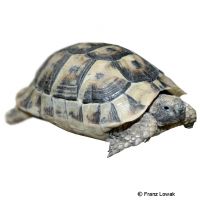Tunisian Spur-thighed Tortoise (Testudo graeca nabeulensis)
| Tunisian Spur-thighed Tortoise Testudo graeca nabeulensis | |
|---|---|
| Name | Tunisian Spur-thighed Tortoise |
| Name Lat. | Testudo graeca nabeulensis |
| Family | Tortoises |
| Family lat. | Testudinidae |
| Order | Turtles |
| Order lat. | Testudines |
| Origin | N-Africa |
| Habitat | Dry savanna |
| Diet | Herbs, veggies, grass, hay |
| Humidity | 40-60 % |
| Behavior | ♂ semi-aggressive |
| Keeping | Individual, harem |
| Care Level | Moderate |
| Reproduction | Oviparous |
| Housing | Dry terrarium |
| Life Span | 50 years |
| Protection | CITES Appendix II; EU Annex A |
| Metric Units | |
| Size | 16-20 cm |
| Temperature | 25-30 °C |
| Temperature Local | 35-45 °C |
| Housing Size | 200 x 100 x 50 cm |
| US Units | |
| Size | 6.3"-7.9" |
| Temperature | 77-86 °F |
| Temperature Local | 95-113 °F |
| Housing Size | 80" x 40" x 20" |
Distribution and habitat
The range of the Tunisian tortoises extends over the entire north of Africa to Sardinia, where they were introduced. They inhabit different habitats, such as dry hilly scrubland (macchie), evergreen oak forests but also fields and gardens.
Maintenance
Minimum dimensions for the terrarium, according to the size and number of animals
| 1-2 animals | 8PL x 4PL (L x W) |
The carapace length (PL) is measured on the largest animal. For each additional animal the footprint has to be increased by10 %, from the 5th animal on by 20 %. A terrarium of e.g.200 x 100 x 50 cm is recommended, which should be placed in a quiet and vibration-free place.
They need a terrarium structured with branches, robust plants and stones, with a graveable substrate, e.g. of sand-loam-gravel mixture, as well as an easy to clean, small water basin for drinking. A small part of the substrate should always be kept slightly moist. In the case of group housing, separate roosting areas should be provided and suitable measures for visual separation should be implemented
| Temp. day: 25-30 °C | Temp. night: 18-22 °C | Temp. local: 35-45 °C | Humidity: 40-60 |
Thermostatically controlled floor heating is recommended. Lighting duration must be 10-14 hrs, depending on the season. They need high light intensity and daily UV irradiation as well as sunny places with radiant heat.
Diet
They are omnivores, but they feed almost exclusively vegetarian. The diet consists of a wide range of wild herbs (plantain, dandelion, parsley, etc.), hay and hay dressings, clover, sweet grasses, mushrooms and vegetables such as lettuce, spinach, cabbage leaves, cucumbers, zucchini and carrots, supplemented with commercial ready-made food for tortoises. Occasionally they require small amounts of animal protein, such as earthworms, snails or grasshoppers, and small pieces of hard-boiled egg. Fruit should be fed sparingly and infrequently because of the fructose content. Regular addition of minerals and vitamins is important. They drink very much (drinking is done through the nose), accordingly, sufficient drinking water must always be available.
A varied diet promotes health and prevents deficiency symptoms.
Reproduction and breeding
Males have a concave ventral carapace and a much longer tail than females. The anal opening of the male is closer to the tip of the tail than in the female.
Mating occurs in the spring and fall. Egg laying occurs between June and August. The female buries her eggs (12-14 pieces) about 15 cm deep, in a sandy southeast facing place. The incubation period is 60-70 days at 28-32 °C. Juveniles require higher humidity (60-80%)
Life expectancy can be 50 years.
Species protection
The animal population must be reported in writing to the competent authority immediately after the start of keeping. Subsequently, all arrivals and departures must be reported
Species protection: WA Appendix II; EU Appendix A. You will receive a certificate with a picture of the animal for clear identification and a proof of purchase as proof of origin upon purchase
Your pet store will be happy to provide you with further information.
Important
Animals from North Africa are active year-round and do not hibernate in the conventional sense, but often take rest periods during the summer.
Free-range husbandry is not recommended.
The terrarium must have good ventilation without drafts and meet the species-specific needs. Measuring devices such as thermometers, hygrometers, etc. are necessary. The lighting has to correspond to the species-specific day-night rhythm and has to be placed in such a way that the animals cannot injure themselves. The terrarium should be locked in such a way that neither unauthorized persons can open it nor the animals can escape. Contamination must be removed regularly
Further literature can be found in your pet store.
References
Text: Christian Sänger; Image: Franz Lowak
Source: BMELV (1997): Tierschutzgutachten - Mindestanforderungen an die Haltung von Reptilien; ENGELMANN (2006): Zootierhaltung - Tiere in menschlicher Obhut: Reptilien und Amphibien, Harri Deutsch Verlag; ROGNER (2009): Taschenatlas Schildkröten, Verlag Ulmer
- Gemäß § 21 Abs. 5 Tierschutzgesetz idgF
